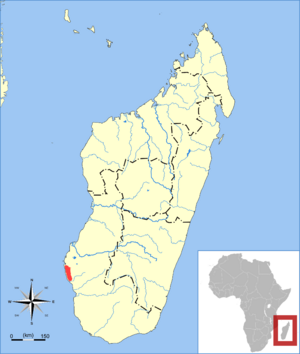Jenkins's shrew tenrec facts for kids
Quick facts for kids Jenkins's shrew tenrec |
|
|---|---|
| Conservation status | |
| Scientific classification | |
| Genus: |
Microgale
|
| Species: |
jenkinsae
|
 |
|
| Jenkin's shrew tenrec range | |
The Jenkins's shrew tenrec (Microgale jenkinsae) is a tiny mammal that lives only on the island of Madagascar. It belongs to a special animal family called Tenrecidae. This small creature makes its home in dry forests and shrubland. Sadly, its home is shrinking, which puts this tenrec at risk.
Contents
About the Jenkins's Shrew Tenrec
This tenrec is very small. It measures about 14 to 15 centimeters (around 5.5 to 6 inches) long, including its tail. Its tail alone is about 7 to 8 centimeters (around 3 inches) long.
Its fur is very thick and soft. On top, it's a brownish color with darker spots. This comes from a special gene called the agouti gene. Its belly is a lighter, grayish color. The tail is dark brown on top and much lighter underneath.
Where Does It Live?
The Jenkins's shrew tenrec lives only in the Mikea Forest. This forest is located in southwest Madagascar, between the towns of Morombe and Manobo River. It prefers to live deep inside the forest.
The Mikea Forest grows on sandy ground. The weather there is quite dry. It gets as little as 350 millimeters (about 14 inches) of rain each year. The trees in this forest are not very tall, usually less than 12 meters (about 40 feet) high. This is shorter than other forests nearby.
The area has a tropical dry climate. This means it has a clear dry season from May to October. The wet season is from November to April. During this time, rainfall can reach up to 750 millimeters (about 30 inches). The average daily temperature in the region is usually between 25°C and 31°C (77°F and 88°F).
Why Is Its Home in Danger?
The Mikea Forest is facing many threats. People sometimes burn parts of the forest on purpose to create more land for farming. There are also accidental wildfires. Another big problem is deforestation, which means cutting down trees for wood.
Many trees in the Mikea Forest are very valuable for building. These include trees like Givotia madagascariense, Cedrelopsis grevei, and Commifora arofy. All these trees are found only in Madagascar. The high demand for them in the construction industry is a major threat to the forest and its animals.
Protecting the Jenkins's Shrew Tenrec
The biggest danger to the Jenkins's shrew tenrec is the loss of its home. This happens because of wildfires and intentional burning. So, it's very important to protect the Mikea Forest.
Right now, the Mikea Forest is not a protected area. But there are plans to make it one. Scientists need to learn more about how many tenrecs there are. They also need to study their habits, where they live, and how they adapt to changes in their environment.
Research is being done to find ways to stop deforestation in the area. Organizations like the World Wildlife Fund are working to protect the Mikea Forest. This is because many other unique species also call this forest home.
Family Tree of the Tenrec
The Microgale jenkinsae belongs to the animal family called Tenrecidae. Most animals in this family live on the island of Madagascar. A few species are also found in central Africa.
Tenrecs look very different from each other. Some look like hedgehogs, while others look like shrews, opossums, mice, or even otters! They live in many different places, including water, trees, or underground. This wide variety happened because of something called convergent evolution. This is when different animals develop similar traits because they live in similar environments.
Scientists believe that the first tenrec arrived in Madagascar about 60 million years ago. It was a very small mammal, perhaps weighing only 5 or 6 grams. It might have floated across the sea from Africa on something like a log. It's not known if other tenrecs came with it, or if it was a pregnant female.
At that time, Madagascar had very few other mammals. This meant the tenrecs had little competition. This led to a process called adaptive radiation. This is when one species quickly evolves into many new species. This process created 34 different tenrec species from that one original ancestor. The Jenkins's shrew tenrec is one of them!
This species is part of a smaller group called the subfamily Oryzorictinae. All tenrecs in this group are found only in Madagascar. Its specific group, or genus, is Microgale. There are 22 different living species of Microgale on Madagascar.
The name jenkinsae was given to honor a British expert on mammals named Paulina D. Jenkins.
What Do Tenrecs Eat?
Tenrecs are often called insectivores, meaning they eat insects. But a better word for them is faunivores. This means they eat many different kinds of animals, not just insects.
Most tenrecs eat small creatures without backbones that live on the ground, like worms or spiders. Some tenrecs will also eat small animals with backbones if they get the chance. These can include frogs, lizards, birds, mice, or even other tenrecs. Some species are also known to eat dead animals.
Even though many tenrec species eat similar things, up to 14 different tenrec species have been found living in the same area. And up to 11 different shrew tenrecs can share the same habitat! Scientists are still trying to figure out how they all find enough food without competing too much. It's a challenging question to answer!


